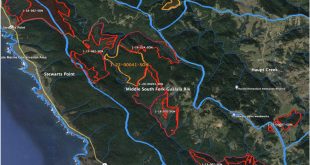| This article was published in the Independent Coast Observer on February 15, 2002. |
The California Department of Forestry, National Marine Fisheries Service, North Coast Regional Water Quality Control Board, Gualala Redwoods, Inc. and representatives of the nearly 80 persons present in the audience, presented a full day of testimony.
The day ended with the Board narrowly (3-2) disapproving the Gualala Redwoods plan and affirming the National Marine Fisheries Service concerns that any logging in a floodplain could disrupt salmon habitat and threaten the recovery efforts of this species facing extinction.
The hearing turned on the definition of “taking” under the Endangered Species Act.
Persuasive testimony was given from both sides. Gualala Redwoods, Inc. manager Henry Alden had Dr. Steven Mader, a specialist in forest ecology of riparian habitat as well as Wayne Whitlock, Esq. From Pillsbury and Winthrop flanking his side.
Alden admitted that the size of the sediment in the river was on the small size for ideal salmon rearing conditions. Alden’s team also acknowledged the salmon population was down, and that the amounts of large woody debris which creates deep pools for salmon to spawn was presently off target in terms of suitability. Nonetheless, Alden insisted the Cassidy Plan would improve salmon habitat and benefit the environment.
He questioned the chain of command, appealing for the Board of Forestry to ask themselves “who’s in charge here” and “why should the State enforce a federal law?”
He declared if the plan is found in disapproval by the Board, the state was opening itself up to lawsuits. Whitlock insisted that the National Marine Fisheries Service wording “would likely result in a take” was too precautionary and that “take” needs to actually occur before an activity can be denied. He argued that denying the plan denies a landowner a right to use their property.
Alden followed in the rebuttal period by stating “I do not mean to be lighthearted but the take on the take would result in the take of our property.” On the other side, National Marine Fisheries Service biologist, Charlotte Ambrose, as well as their fluvial geomorphologist presented arguments on how the Cassidy Timber Harvest Plan would impact the fish habitat and result in a “take.” They predicted major channel changes and aggradation of the streambed which would continue degrading fish habitat and explained how maintaining the riparian habitat prevented forced water flows into the streams. They scientifically illustrated the importance of the riparian habitat for salmon.
While the hearing was specific to the Cassidy Plan, there was a tremendous amount of discussion concerning the treatment of the watershed by the landowner. It was well-demonstrated by National Marine Fisheries Service staff as well as staff from the North Coast Regional Water Quality Control Board that nearly 80% of Gualala Redwoods lands have been harvested in the last decade and that this level of harvesting not only does not comport with industry standards but makes it virtually impossible to restore declining fish populations.
The discomfort of Board members required to make such a crucial decision was felt and heard. One Board member believed they were in a position of resolving the proverbial state of the dueling scientists. But, as the sun set on the affair at hand, it was clear the decision would be determined by the outcome of the legal arguments.
Providing summary rebuttal, Mr. Whitlock representing Gualala Redwoods, Inc. presented his case. Norm Hill, representing California Department of Forestry gave his final words. With 3 ayes and 2 no, the Board decided that the Cassidy Timber Harvest Plan did not conform with its rules and regulations and a formal disapproval was registered.
Britt Bailey is on the staff of the Center for Ethics and Toxics in Gualala.
 Friends of Gualala River Protecting the Gualala River watershed and the species living within it
Friends of Gualala River Protecting the Gualala River watershed and the species living within it


